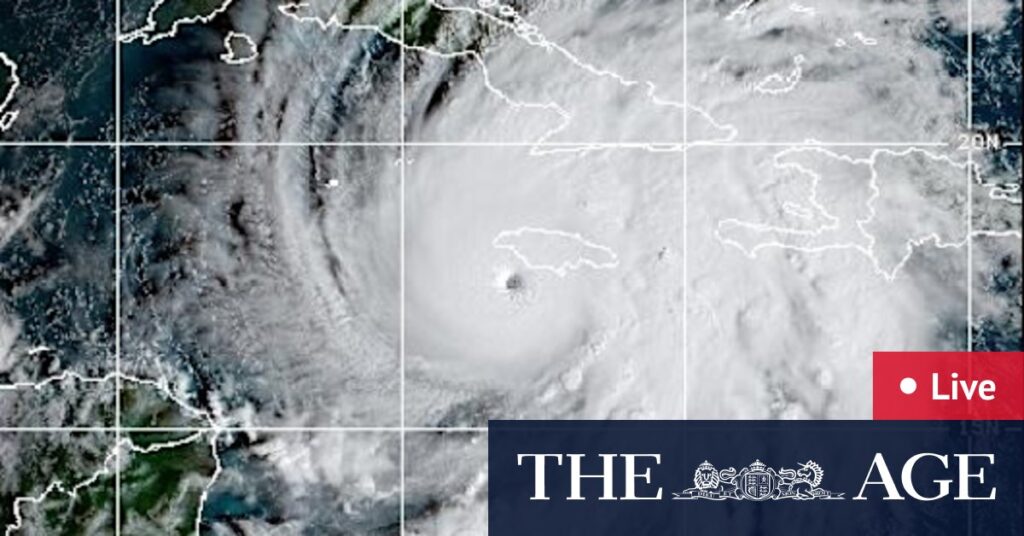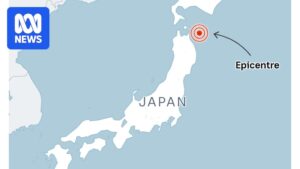
Jamaica is in crisis mode as Hurricane Melissa, a Category 5 storm, makes landfall, unleashing extreme weather conditions that threaten lives and infrastructure across the island. The storm, described as the “storm of the century,” struck near New Hope in Jamaica’s southwest early Wednesday morning, according to the US National Hurricane Center (NHC).
Initially classified as a Category 5 hurricane, Melissa was downgraded to Category 4 shortly after landfall but remains “extremely dangerous,” with sustained winds reaching 300 km/h. This marks the strongest storm to hit Jamaica since record-keeping began 174 years ago. The storm’s path is set to traverse the island, bringing with it torrential rain, damaging winds, and a life-threatening storm surge.
Unprecedented Impact and Response
The hurricane has already claimed seven lives across the region, with three fatalities reported in Jamaica. The storm’s impact has left at least 240,000 residents without power, particularly in the southwestern parts of the island. Emergency services are on high alert, though many roads are blocked by debris, complicating rescue efforts.
Prime Minister Andrew Holness expressed grave concerns, stating that the southern part of Jamaica is expected to suffer catastrophic damage beyond the country’s disaster response capabilities. “The impact is really in the south of the island, and I am praying for those residents,” Holness told CNN, emphasizing the dangers posed by the storm.
Comparisons to Past Hurricanes
The NHC has compared Melissa’s power to Hurricane Katrina, which devastated New Orleans two decades ago. Katrina’s maximum winds were less intense than Melissa’s current 300 km/h gusts, underscoring the unprecedented nature of this storm. Meteorologists have noted that Melissa’s central pressure of 892 millibars ties the record for the strongest Atlantic storm at landfall, matching the 1935 Labor Day hurricane in Florida.
Environmental and Safety Concerns
As the storm batters the island, residents are also facing additional threats from displaced wildlife. The South East Regional Health Authority has warned of potential crocodile sightings in residential areas due to rising water levels. Residents in Kingston, St Andrew, St Catherine, and St Thomas have been advised to exercise extreme caution and avoid floodwaters.
Meanwhile, hospitals remain on high alert, prepared to provide emergency medical assistance, though smaller health centers have been forced to close. The American crocodile, native to Jamaica, typically inhabits mangroves and coastal lagoons but may be displaced by the storm’s flooding.
Scientific Insights and Climate Context
Experts have highlighted the role of climate change in the intensification of hurricanes like Melissa. Akshay Deoras, a meteorologist at the University of Reading, noted that the Caribbean’s sea surface temperatures are currently two to three degrees Celsius above normal, providing a vast reservoir of energy for the storm.
“That part of the Atlantic is extremely warm right now – around 30 degrees Celsius,” Deoras explained, adding that the deeper ocean layers are also unusually warm.
Research indicates that tropical cyclones are moving slower globally, a trend linked to climate warming. This slower movement allows storms to linger longer over affected areas, increasing rainfall and potential damage. Melissa’s creeping pace has amplified concerns, as it allows the storm to maintain its destructive force over Jamaica for an extended period.
Community and International Response
Jamaican authorities have predicted that up to 50,000 people could be displaced by the storm. However, as of Monday evening, only about 1,700 residents had evacuated to shelters, according to Local Government Minister Desmond McKenzie. Efforts are underway to encourage more residents to seek safety in designated shelters.
International organizations, including the United Nations, have labeled Melissa as the “storm of the century,” urging global support for Jamaica’s recovery efforts. The island’s resilience will be tested in the coming days as it deals with the aftermath of this historic storm.
As Hurricane Melissa continues its path towards eastern Cuba, the focus remains on ensuring the safety of those in its wake and assessing the full extent of the damage. The coming days will be critical in determining the long-term impact on Jamaica and its recovery process.






